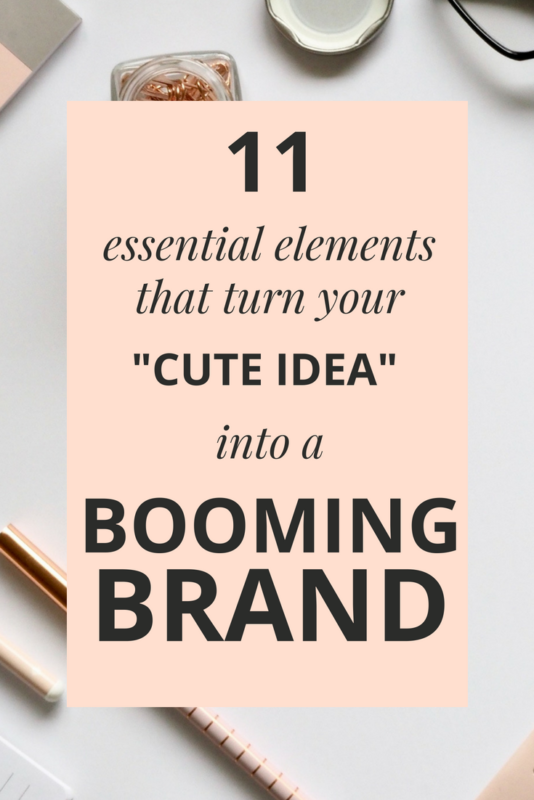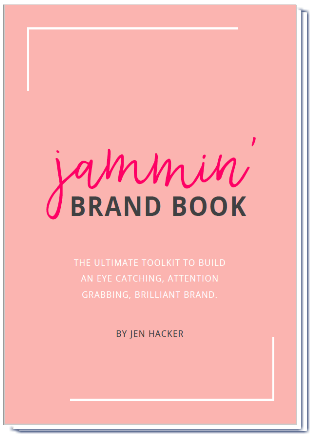11 Essential Elements That Can Make or Break Your Brand

Last week I was sitting around a circle with a group of other women entrepreneurs. Most of us there were solopreneurs, a handful a dynamic team of two. We had been asked to share what the biggest challenge has been in building our businesses.
One woman raised her hand and shared that her friends couldn’t seem to take her business seriously.
A round of head nods passed around the circle. It seemed we’d all been on the receiving end of commentary of that sort.
Deciding to build a business is an enormous undertaking. The sheer task of creating something from nothing requires nothing short of brute strength and determination. So why is it that despite their best efforts, many new business owners find that they’re being met with doubt and aren’t being seen as a “real business”?
From what I’ve experienced, the distinction comes down to the fundamental building blocks that are put in place during the birth of an idea. They’re the not-so-sexy steps that come ahead of choosing a name, creating a logo, and building out a website. To reference an admittedly overused analogy, think of those things as the tip of the iceberg. It’s what everyone sees. Yet, the bulk of your brand, the thing that keeps it afloat is hidden beneath the surface.
I wanted to put together this post to shed light on those essential elements that generally lie hidden but ultimately can make or break your brand. These are the things that set you up for long-term success, differentiate your business from everyone else’s, allow you to cultivate a community and give a greater purpose to your work. If you look across the board and the brands that really stand out, create a buzz, and ultimately find success, you can find each of these essential elements in place.
11 Essential Elements That Turn A “Cute Idea” into a Booming Brand
Clear Brand Message
Your brand message is the clear, concise articulation of what service or product you offer, who it’s for, and how it is unique. Think about it as your elevator pitch. It’s your response to the question, “what do you do?” or, “what is (insert name of your brand)?”.
A well-written message can be a powerful tool for bringing focus and clarity to your business. It’s also what is going to make you memorable and referrable.
Likewise, an unclear message will not only leave you feeling confused but also your audience. And remember this, if you confuse people, you lose people.
How to use it
- As your social media bio
- The meta description for your website aka the words that show up in search results
- The key message at the top of your website’s homepage
- Any public facing bios (guest posts, interviews, speaking engagements)
Compelling Brand Story
Your brand story explains how your brand originated and plays a critical role in helping you to attract your ideal customers and establish a trusting relationship with them. It gives context to where your idea came from, how you brought it to life, and most importantly explains why your brand exists.
When you share your story it humanizes your brand and gives people something they can relate to. When you have a great story to tell it can also help create word of mouth sharing with your customers. It can even be the thing that captures the attention of the media and lands you amazing press.
How to use it:
- An “About” page on your website
- In your media or press kit
- Write it into your brand book
- In the content your brand creates (blog post, video, social media)
Rock Solid Values
Your brand values are the deeply held beliefs and principles by which your company operates. They serve as a moral guide and a framework for how you run your business. Your values make it clear to your team, your customers, and your partners what you care most about.
Establishing a set of rock solid values will give you a framework against which to assess whether or not something is the right thing to do. Deciding whether or not you to need to invest in sustainable packaging? If being eco-friendly is a core value then you’ll be assured it’s the right move.
Strong values will also help you form deeper bonds with your customers. In fact, 64% of people cite shared values as the main reason they have a relationship with a brand. Beyond attracting loyal customers, a clearly established set of values is going to help attract the right people to join your team which becomes important as your team grows.
How to use them:
- Share them on your website
- Include them on your hiring page or in job descriptions
- To help you decide on packaging materials
- To guide who you choose to partner with
- When figuring out which causes to support
Purpose Driven Mission
Your brand mission explains your brand’s reason for being. It answers the question “why does your brand exists?”. We write our brand mission statement in order to inspire everyone around our brand to drive toward the same goal, not matter what their role is – team member, partner, or customer.
Your mission statement will guide the activities your brand engages in beyond selling products whether its philanthropic endeavors, support for a specific cause, or the way you do business.
Sharing it with your customers will help them understand how their support for your brand aligns with their personal values. Similarly, sharing it with your team and partners will help them see the bigger picture their work contributes to.
How to use it:
- On your website
- To align your brand with a charitable cause
- To develop a natural extension of your online brand into workshops or live events
Empowering Vision
What is your ultimate dream for your business? What is it that you’re aspiring to? The answer to those questions is your brand vision. It should feel aspirational and serve as a true source of inspiration for your team.
Your brand vision is your long-term goal born out of your “big why” or underlying motivation. It sets the long-term strategy for your brand and serves as your guiding light or north star.
Everything that your brand does should get you a step closer to fulfilling your vision. If it doesn’t, you should question why you are doing it.
How to use it:
- Unlike your brand mission statement, your vision statement does not necessarily need to be outward facing (though it can be). The primary function of a vision statement is to inspire your team and the best way to do that is to keep it front and center.
Life-like Customer Personas
Your target customers are the ones who you believe your product or service is best suited for. They are the people who you want to buy from you and who you are going to focus all of your efforts finding, attracting, and keeping loyal to your brand.
Customer personas are a way of bringing to life your ideal customer by turning them into a fictional character that represents who they are. You might also hear these referred to as buyer personas or custom avatars. The idea is the same. They are a way of turning data points into something that feels human.
Creating customer personas will help you stay rooted in who you’re serving and how to best connect with and serve them.
How to use them:
- To help you determine which services/products to sell
- When evaluating where to set your prices
- To inspire the development of your brand’s visual style
- To inform the content you create (what you share and where you share it)
- When deciding who your brand should partner work with
- When setting up audiences for paid marketing campaigns
Brand Personality Pillars
Think of your brand personality as the way your brand would think, speak, and behave if she were a person. Your brand personality pillars are the keywords that describe your brand’s most recognizable traits – for instance, quirky, sophisticated, adventurous, bold, or witty.
We want to remember that people don’t fall in love with brands because of what they sell. They fall in love with what a brand promises to do for them and how that brand makes them feel.
Your brand personality is what your customers will connect with and gravitate to.
How to use them:
- Provide the structure for deciding how your brand does and doesn’t act
- Guide the development of your brand style (colors, fonts, visuals)
- How you talk to your customers through your website copy, emails & social captions
Brand Mood Board
A brand mood board is a collection of visuals that bring to life your brand’s personality. You can build them IRL or create them online. Either way, the point of creating a mood board is to capture the essence of your brand.
Your mood board becomes the jumping off point for the development of your visual identity – colors, typography, logos, and images. It’s going to help you visualize what you like and what makes sense so that when it comes time to make your final choices it’s much easier to decide.
How to use it:
- Ultimately your mood board will guide the design for things like your website, social media posts, product packaging, and collateral.
Brand Voice Guidelines
Your brand voice is not just what you say but how you say it. Just like your own voice, it is built from the combination of your words, known sayings, grammar, inflection and even accent.
Your brand voice will not only play a critical role in bringing out your brand’s personality but it will also establish a relationship with your customers and can even help to build a sense of community between them.
In your business, your brand voice comes through in every way you communicate with your customers. This includes everything from your product names and descriptions to email and blog copy.
Consider your brand voice when writing:
- Copy for your website
- Blog posts
- Email newsletters
- Social media captions
- Advertising taglines
- Slogans for merchandise
- Copy for your packaging
Brand Style Guide
When it comes to styling your brand, your logo, colors, fonts, graphics, and photography all play a role in establishing what your business stands for in the hearts and minds of the world. These elements work together to exemplify your brand purpose, communicate who your brand is for, and show off your brand personality.
Developing a cohesive style is what is going to enable you to develop a brand that authentically represents who you are. Knowing how to use that style consistently across all of your branding is what is going to allow you to create a business that is distinct and memorable.
A brand style guide is one-page sheet that serves as a quick reference for the core elements of your brand identity so you can keep everything looking cohesive.
How to use it:
- When developing your brand website
- Putting together a brand photoshoot
- Creation of branded collateral
- Development of product packaging
- Designing graphics for social media and advertising
Brand Book
A brand book, sometimes called brand guidelines or a style guide, is a set of guidelines that explain who your brand is, what it’s all about, and how it should be brought to life. Think of it as the one stop shop for all the strategic & tactical guidelines for all aspects of your brand
Your brand book will become your go-to source for everything related to your brand. It should guide your strategy and inform all creative executions. It should become the single source of truth and reference whenever you find yourself asking, ‘is this on brand?’.
One of the keys to developing a brand that stands out and is memorable is to create a consistent experience wherever you customers find your brand. Having a brand book will help you to keep everything looking, feeling, and sounding cohesive toa s your business grows.
How to use it:
- Guide your decision making as the visionary of your brand
- Onboard new team members or partners
- Inspire creative work from designers, photographers, copywriters, and others
- Develop “on-brand” activations with partners and influencers
Where do we go from here?
If you’ve read this post you might be feeling slightly overwhelmed. There are a lot of pieces that need to work together in order to create a super solid foundation upon which your brand can grow.
The truth is trying to tackle everything on your own can be downright intimidating. But here’s the thing, you don’t have to do it all alone! Building your brand should be fun. And, when you know what to do, the whole process can actually feel really easy and empowering.
If you would like a hand building your brand then I want to invite you to join me at Brand Camp. Brand Camp is a 6-week program that teaches women how to build wildly successful brands they are ridiculously proud of while bringing them into community with other bossbabes. We’ll go from idea to execution to turn your passion into the profitable brand you’ve been dreaming of.
You can find all of the sweet deets at Brandcampcourse.com.





























